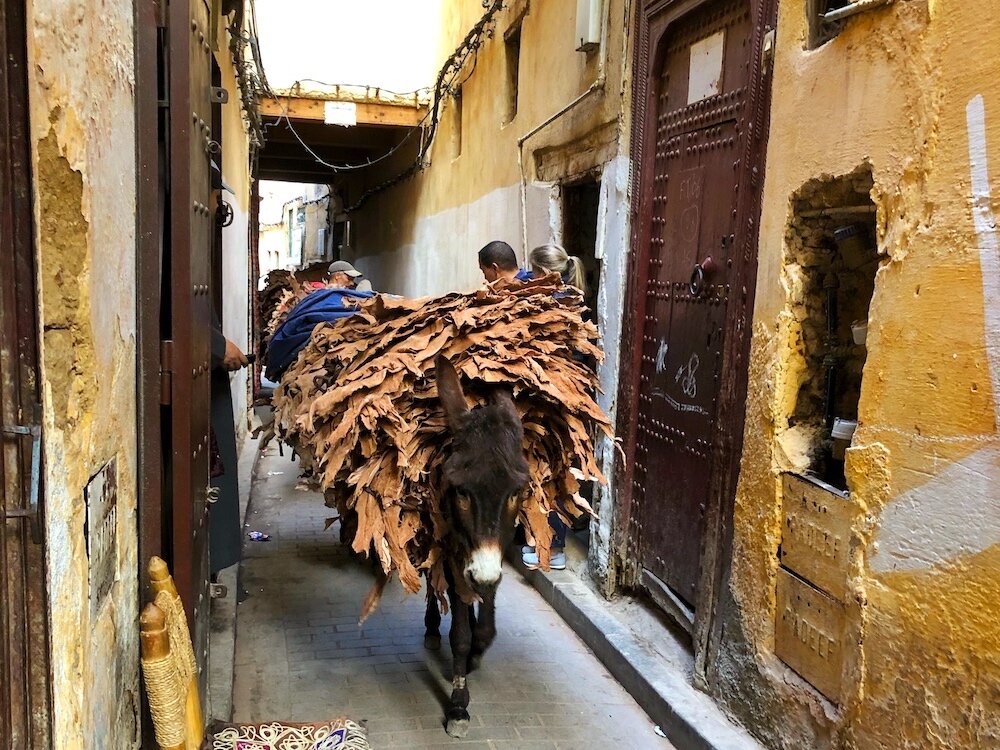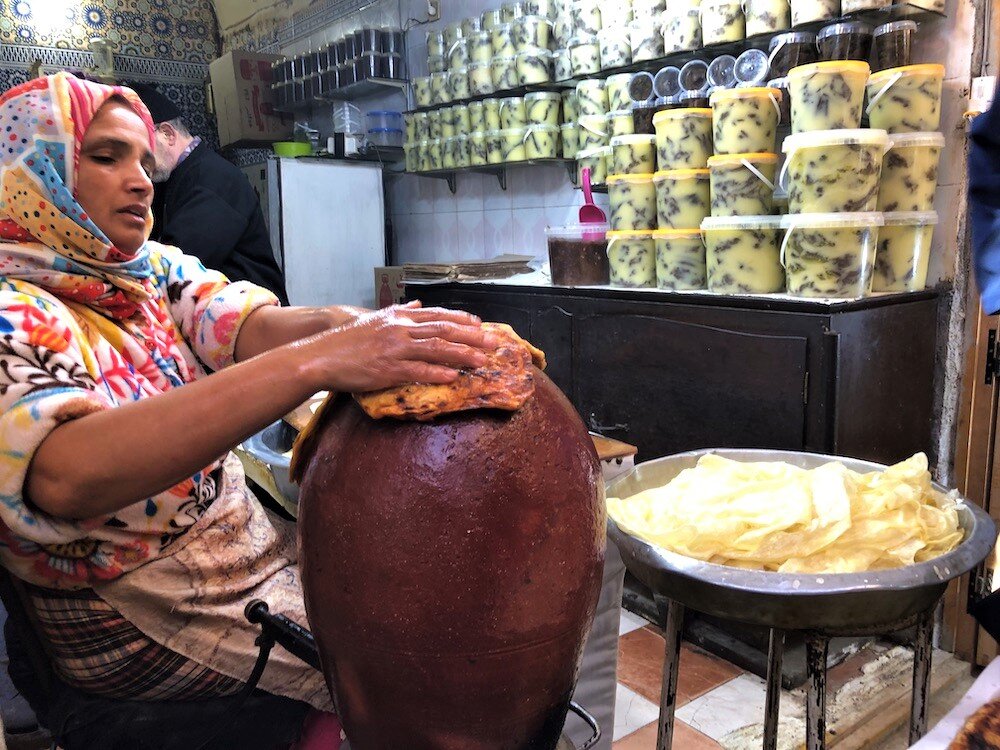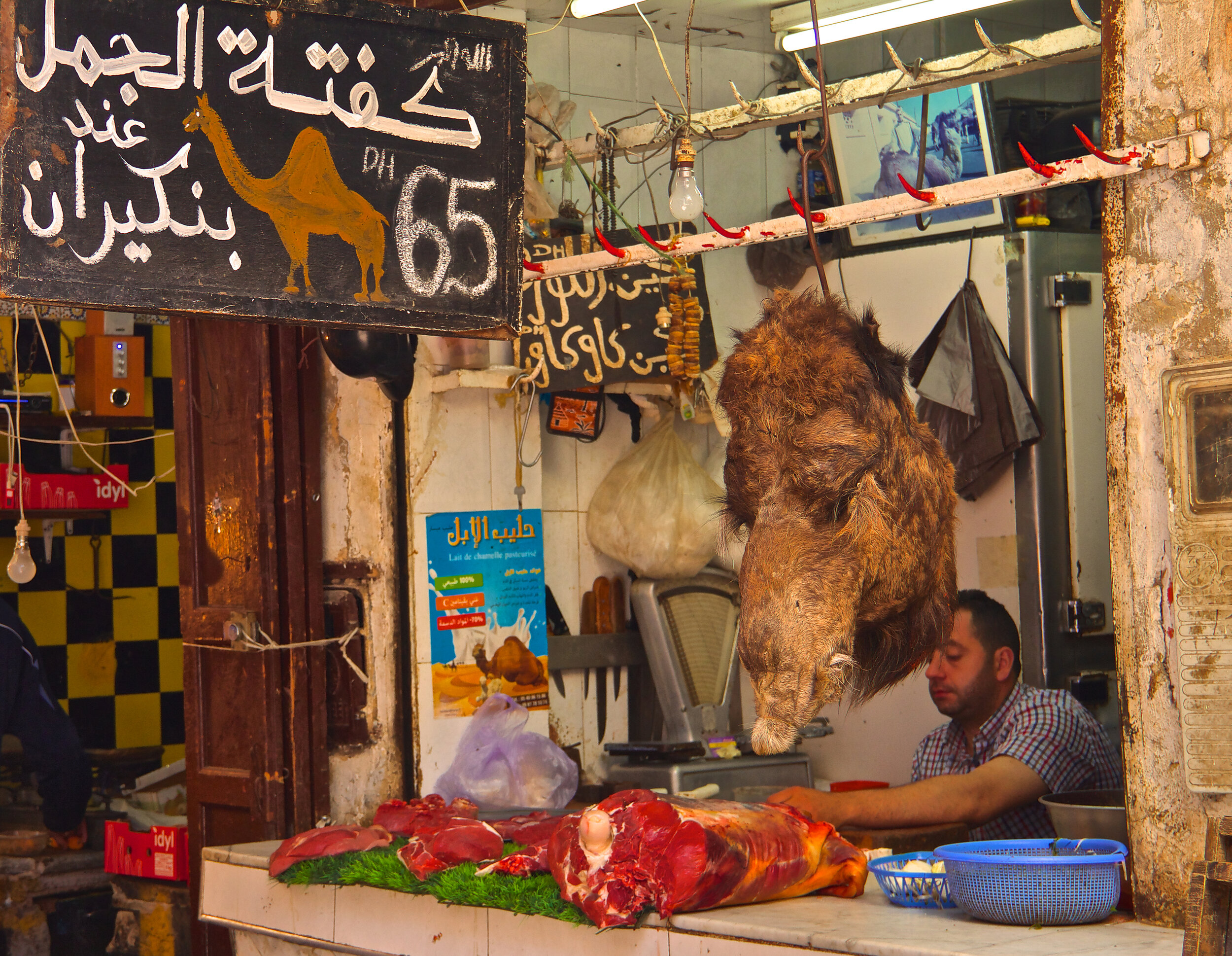The Best Moroccan Street Food in Fez
Leather tannery in the Fez medina.
Finding Moroccan Street Food in Fez
If you are interested in tasting Moroccan food, especially Moroccan street food, you must head to Fez, Morocco. A city of incredible contrasts, Fez is both beautiful and dilapidated. The culinary capital of Morocco is an astonishing city, full of culture, spectacle, and history.
The ancient medina of Fez, a UNESCO World Heritage Site, has remained unchanged for a thousand years. This dark and unforgiving place evokes strong feelings in most visitors who are often under-prepared for the sensual impact. Whether you love or hate the disorder and chaos of the medina, you must visit Fez if you’re road tripping in Morocco.
The medina of Fes el-Bali is home to 70,000 people, who live, work and shop within its ancient walls. The tangle of “drebs” or streets, alleys, dead-ends, and squares are almost impossible to negotiate. But here is where you’ll find some of the best food in Morocco.
Impenetrable high walls and deep cover means navigation apps give up, leaving you to wander around the largest pedestrian area in the world, and hope you don’t get lost. Locals use hand carts and donkeys to carry goods and loads, and the cries of “balak, balak” (“look out, look out”) ring in the air.
In a country where many live hand-to-mouth and modern supermarkets really only exist to cater to the wealthiest in large cities, the souks of Fez play an important role in Moroccan food culture. Suppliers to restaurants, housewives (many of whom don’t have fridges) and workers looking for a quick bite, flock to the Moroccan food markets here which take place seven days a week and go on well into the night.
Wander any of the alleys in Fez and you’ll find stalls and carts selling an amazing array of goods, beautifully flavored traditional Fassi (Fez style) street food, and Moroccan desserts.
The Best Moroccan Street Food in Fez
Check out our list of 145 Fun Street Food Quotes & Captions
M’smen—A Typical Moroccan Breakfast
A traditional crispy pancake made from flour and semolina, M’sem is a popular food in Morocco. The dough is stretched wafer thin and cooked on a large iron dome, which is heated from a gas bottle, using a foot pump.
Costing just a few dirham, and often eaten as a Moroccan breakfast with honey and a glass of whisky berber, also referred to as mint tea. This flaky bread is delicious when eaten plain right after it’s made..
Alternatively, try it stuffed with tomato, onion, and olives or use it as a scoop for rich and creamy bissara soup, made from split broad beans and eaten for breakfast.
You’ll find M’smen stalls and stands in all the different souks of the medina, many also sell other types of Moroccan breads and pastries.
Even if you only have one day in Fes, you’ll want to make sure you see M’smen being made and try it fresh off the dome!
Camel Burger—Moroccan Fast Food
Elsewhere in the medina is Cafe Clock, serving up their infamous camel burger daily. Camel is a pretty staple source of protein in Moroccan Cuisine. Driving around you will pass countless roadside farms selling camel milk or camel meat tajines.
In the souks of Fez, whole camels hang ready for butchering, their tongues lolling and gore dripping into the gutters which run around the medina, passing by sacks of flour, almonds, olives, figs, dates, and aubergine.
But Cafe Clock provides a more sanitized (and westernized) experience, serving their camel burger with cheese and ketchup, and with sides of fries and slaw.
Camel meat is leaner, richer in protein and lower in cholesterol than all other red meats. The hump is the tastiest part, the equivalent of a beef tenderloin, it is fattier and juicier than the rest of the animal and used for burger patties.
Flavored with traditional Moroccan spices: mint, cumin, coriander and paprika, as well as dried rose petals, the burger has a subtle, yet unmistakably, Moroccan flavor.
You can now eat a camel burger in Marrakech and Essaouira, but the original was developed in the Imperial City, making it a true star amongst the street food in Fez.
Pastilla or B’stilla—Traditional Moroccan Cuisine
A must-try Moroccan street food, pastilla (coming from the Spanish word for pill) is a delicious Moroccan sweet and savory meat pie made with shredded chicken (historically pigeon) topped with crushed almonds and cinnamon.
This gorgeous mix is then wrapped in werqa dough, similar to filo pastry, and fried in a skillet before being topped with honey and a pinch of icing sugar. Perhaps surprisingly, it is not overly sweet, and the balance of flavors is perfect.
Buy them freshly cooked from a stall and eat with your fingers - absolute heaven!
As you eat your chicken pie, be mindful to avoid the numerous chicken shops that litter the souks. Chicken in Fez is not bought in a polystyrene tray with sanitary cling-film keeping it fresh and appetizing.
Rather, it is selected when alive and strutting in a cage, stacked with hundreds of other cages, all tiny homes to chickens on death row. Pick your chicken and wait while the shop owner slits its throat and prepares it for you. Unless you have a very hardy constitution, this is a sight best avoided when eating!
Brochettes—Enjoy with Moroccan Bread
Although Fez is long free of the rule of France, the French word remains in use to describe meat skewers which are also called kebabs in Mediterranean cuisine.
All around the medina, billowing smoke and the delicious smell of roasting meat signifies el ghda or lunch, the main meal of the day.
Brochettes can be made up of any meat: turkey, beef, lamb, or a mix of all. You can even choose sheep’s brains if you’re feeling brave. Eating in Morocco can be an adventure!
The meat is cooked after marinating in traditional spices and then de-skewered, before being stuffed into khobz, the ubiquitous round bread of Morocco, and covered in harissa, a deliciously sweet and spicy red pepper sauce.
Mister Ayachi’s small shop is the best place to try brochettes in Fez.
Snails—Popular Moroccan Snack
You can spot the snail stands by the large string sacks of escargots hanging from whatever suitable doorway is nearby.
Cooked in huge steaming pans of broth, snails are a favorite Moroccan street food, especially in the colder months. Like in French cuisine, the snails are served in their shells in a small bowl of the hot and aromatic broth in which they are cooked.
Pick the snails out of their shells using a safety pin, earring post or iphone sim card pin (yep, whatever you have available!) and then slurp the broth from the bowl.
Although snails can be a little on the chewy side and don’t really taste of much at all, they are a popular food in Morocco.
Mint Tea—Vital in Moroccan Food Culture
Mint tea, a staple of traditional Moroccan cuisine, will be offered to you everywhere. If you step into a shop, buy bread, chat with a vendor outside his establishment or even so much as look at a carpet, you’ll be offered a glass of whisky berber.
To refuse is considered rude, so no matter how mint-tea’d out you are, accept, smile, and suck it up! The tea is delicious, made with boiling water, a large handful of mint leaves and huge quantities of sugar. After steeping for a few minutes in a silver, long spouted pot, it is poured from a great height into a tiny glass.
Without doubt, much of this is theatre, but mint tea is also a traditional Moroccan welcome and an important part of any business negotiations, which won’t take place until the tea is finished.
Olives—At the Moroccan Food Market
The hills around Fez are covered with the silver green of olive trees, so it’s no surprise that they are added to many dishes, crushed for their oil, and eaten as they come in the streets of the city.
Often the olives are flavored with herbs like rosemary, oregano and thyme or doused in lemon juice or harissa paste.
The olive stalls of any Morocco food market are a real feast for the eyes. The beautifully colored olives arranged in perfect pyramids are catnip for photographers. Make sure you ask before snapping that perfect Instagram shot; many Moroccans don’t like having their picture taken for religious reasons.
Chebakia—Must-Try Moroccan Dessert
A sticky and sweet snack made with strips of dough, deep fried like a doughnut, and coated in syrup or honey, then sprinkled with sesame.
At stalls you will see them stacked high and served in paper cones as a Moroccan dessert.
In restaurants and cafes, they are often served with harira, the hearty lentil and chickpea soup that’s a favorite across the country.
Famous Moroccan Foods
We’ve discussed some of the best Fez street foods, however, we left out 2 of the most famous foods in Morocco: couscous, the Moroccan national dish, and Moroccan tagine, because you will not typically find them as a grab-and-go street snack in Fez.
Rather, these 2 Moroccan food staples that frequently appear together will be found most often in homes or Moroccan restaurants in Fez and throughout Morocco.
So, I encourage you to try these 2 famous Moroccan dishes but then head to the streets and enjoy the Moroccan street foods!
Similar to some of our other favorite foodie cities like Mexico City, Oaxaca, Beijing, Taipei, and Tokyo, partaking in the street food scene of Fez is a great way to engage with the locals, to learn about the Moroccan food culture, and to have fun!
Have you been to Morocco? Do you love street food? Let us know in the comments!
About the Authors
Izzy and Phil, aka The Gap Decaders, have spent the last three years touring Europe and Morocco in their motorhome. After corporate careers that failed to excite them, they sold their house and most of their possessions before hitting the road and unexpectedly becoming bloggers. Find Izzy and Phil online: Facebook | Twitter | Pinterest | Instagram
Lick it to Pin The Best Moroccan Street Food in Fez!













